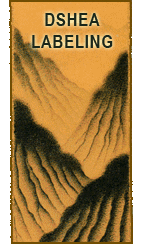DSHEA Tutorial: Designing Your Label

Chinese herbal medicines in powders or capsules that are manufactured and dispensed from the office of a private practitioner are generally placed into one of two size containers.
- 150 cc bottle which can hold 100 capsules or 100 gm. of powdered extract.
- 250 cc bottle which can hold 200 capsules or 200 grams of powdered extract.
It should be noted that capsules take up much more space than the straight forward powder. 100 capsules contain approximately 50 grams of powder. 200 capsules contain approximately 100 grams of powder.
The bottle label design that we’ll be using in this tutorial does not take into consideration that size and availability of labels that are actually cut to appropriate sizes. The goal of this tutorial is to demonstrate what labels need to include. Fitting them on to a 2″x4″ self-adhesive label is a design question more than a legal issue, so I’ll be ignoring that particular problem.
How does one label or package raw herbs or bulk herbs? This is really a big unknown. It may be that those packages of raw herbs are regulated in the same way as a food product that you might find at a grocery store. At this point (baring any better legal advice), I would approach raw herbs as something along the lines of purchasing produce from a neighborhood grocer. No specific labeling is required, though of course regulations in terms of cleanliness, etc. would apply.
Next: the nifty yin/yang symbol for our bottle label.
 Last modified: August 31, 2009
Last modified: August 31, 2009  Tags: DSHEA, Labeling В· Posted in: Labeling
Tags: DSHEA, Labeling В· Posted in: Labeling
